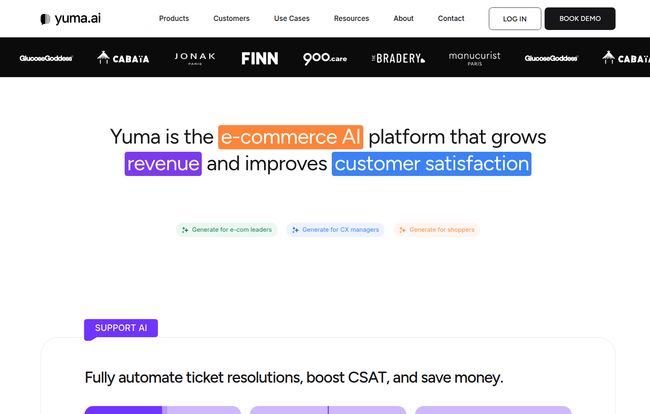Alright, let’s have a real chat. If you’ve been in the e-commerce game for more than a week, you know the feeling. The morning coffee tastes great until you open your helpdesk. And there it is. A fresh wave of tickets. “Where’s my order?” “How do I make a return?” “Do you ship to Antarctica?” It’s a never-ending tide that can drown even the most dedicated support team.
For years, the solution was either to hire more people—which gets expensive fast—or to throw a clunky, first-generation chatbot at the problem. You know the ones. They infuriate customers more than they help, creating more tickets for your human agents to clean up. Fun times.
I’ve seen dozens of AI “solutions” pop up, each promising to revolutionize customer support. Most of them are just lipstick on a pig. But every so often, something comes along that makes me lean in a little closer. Recently, that something has been Yuma AI. It's been making some noise, and I wanted to see if the hype was real or just more marketing fluff.
What Exactly Is Yuma AI? (And Why It’s Not Just Another Chatbot)
First off, let’s get this straight: Yuma isn’t a customer-facing chatbot that lives in the corner of your website. Thank goodness. Instead, it acts as an intelligent assistant for your existing support team, living inside the helpdesk software you already use, like Gorgias or Zendesk. Think of it less as a robot replacing your team and more like a brilliant, hyper-efficient intern who drafts perfect responses and handles the repetitive stuff, freeing up your pros to handle the tricky cases.
Yuma uses generative AI—the same kind of tech behind tools like ChatGPT—but it's been specifically trained on the ins and outs of e-commerce. It understands the difference between a refund and an exchange, knows how to check an order status, and can interpret the customer's tone. The goal here isn't just to send a reply, it’s to achieve autonomous resolution. That means it actually solves the customer’s problem on the first go, often without a human even needing to touch the ticket.
That’s a pretty big claim, and honestly, it’s the part that got my attention.
The Yuma AI Difference: Key Features That Stand Out
When you peel back the layers, a few things about Yuma's approach feel different. It’s not trying to be an all-in-one platform that forces you to change your entire workflow. It’s smarter than that.
It Plays Nice with Your Existing Tools
This is huge. The last thing any busy e-comm manager wants is to migrate their entire support operation to a new platform. Yuma gets this. It’s built to integrate directly into leading helpdesks. From what I’ve seen on their site, they work with the big players that most Shopify stores are already using. This means the learning curve for your team is minimal. The AI just appears inside their current workspace, ready to help. No ripping and replacing. Just a simple, powerful addition.
It Takes Real Action
Many AI tools just draft text. They’ll write up a nice-sounding email, but your agent still has to go into Shopify, check the order, process the return, and then hit send. Yuma aims to go a step further with what they call “autonomous actions.” It can be configured to perform tasks on its own—like initiating a return in your system or updating a customer’s shipping address. This moves it from a simple writing assistant to a true workflow automation tool. And that saves real time.

Visit Yuma AI
Impressive Automation Rates
Yuma’s website tosses around some pretty impressive numbers, claiming an average automation rate of 79% and some case studies hitting as high as 88%. Now, as an old hand in this industry, I always take stats like these with a grain of salt. Your mileage will vary based on your products, your customers, and your common ticket types. But even if you only achieved half of that—say, 30-40% automation—what would that mean for your business? For many stores, that would be a complete game-changer, eliminating a massive chunk of their daily ticket volume.
The Real-World Impact on Your Store
So, what does all this tech actually do for your store's health and your own sanity? It really boils down to a few key benefits.
First, your agent productivity goes through the roof. When AI handles the 400th “where is my order” ticket of the week, your human agents can focus on a high-value customer who needs a personalized product recommendation or a frustrated user who needs a delicate touch. This leads to better service and, frankly, a happier, less burnt-out support team. Second, this directly translates to reduced operating costs. Fewer hours spent on support tickets means a lower cost per ticket and the ability to scale your revenue without your support headcount—and payroll—exploding alongside it.
And most importantly, it can seriously improve customer satisfaction. Yuma claims a 70% increase in CSAT for its users. I believe it. Why? Because customers don’t want to wait 24 hours for a simple tracking link. They want fast, accurate, 24/7 answers. An AI that provides instant, correct resolutions is a better experience than a slow human, every single time. This speed builds trust and loyalty, which is the holy grail in e-commerce.
Let’s Talk Money: Breaking Down Yuma AI’s Pricing
Okay, the part everyone's waiting for. How much does this magic cost? Yuma’s pricing model is… interesting. Instead of charging per user or per total ticket, they charge per automated resolution. I have mixed feelings about this, but I see the logic.
Essentially, you only pay when the AI successfully closes a ticket on its own. If it just drafts a suggestion that your agent has to edit and send, it doesn't count. This is a clever “put your money where your mouth is” approach. The risk is shared. If the AI doesn’t perform, you don’t pay as much. The potential downside is that your monthly cost could be a bit unpredictable if your ticket volume fluctuates wildly.
Here’s a quick look at their standard plans:
| Plan | Monthly Cost | Included Resolutions | Overage Cost |
|---|---|---|---|
| Starter | $350 | 500 | $0.70 per resolution |
| Growth | $650 | 1,000 | $0.65 per resolution |
| Scale | $900 | 1,500 | $0.60 per resolution |
| Enterprise | Custom | 15,000+ per year | Starts at $0.55 |
All plans seem to include unlimited total tickets, dedicated support, and a 30-day free trial. This free trial is a big deal. It lets you test the waters and see what your actual automation rate looks like before you commit a single dollar.
The Other Side of the Coin
No tool is perfect, and it would be dishonest to pretend otherwise. While I’m optimistic about Yuma, there are a few things to keep in mind. The variable pricing, while fair, could be a headache for businesses that need very predictable monthly expenses. You also have to have a compatible helpdesk already in place; it’s an add-on, not a standalone solution. Lastly, like any AI, its effectiveness is only as good as the data it’s trained on and the systems it connects to. If your backend processes are a mess, the AI might struggle to find the right answers.
My Honest Take as an E-comm Veteran
So, what’s the final verdict? I'm genuinely intrigued. In a sea of AI noise, Yuma seems to have a smart, practical approach. By focusing on augmenting human agents rather than replacing them, and by integrating with existing workflows, they’ve sidestepped the biggest hurdles that cause businesses to reject new tech. The model of charging for success (resolutions) is bold and shows a lot of confidence in their product.
I remember a client from a few years back, a fast-growing apparel brand. Their support team was amazing but they were completely buried. They had to implement a hiring freeze, and CSAT scores started to dip because response times were lagging. A tool like Yuma would have been a lifeline for them—allowing them to handle the increased volume without increasing headcount, and keeping their customers happy. It feels like the right tool at the right time for so many Shopify stores hitting that awkward growth phase.
Is it a silver bullet that will solve every customer service problem? No. But it looks like a powerful, well-designed weapon to add to your arsenal. For any Shopify brand feeling the pain of support ticket overload, that 30-day free trial seems like a no-brainer.
Frequently Asked Questions about Yuma AI
How is Yuma different from a regular chatbot?
The main difference is its purpose and placement. A chatbot is a customer-facing tool on your website for initial contact. Yuma works inside your helpdesk (like Gorgias or Zendesk) as an assistant for your support agents. It focuses on drafting full responses and automating resolutions for tickets that have already been created, rather than just answering basic FAQs on your homepage.
What helpdesks does Yuma integrate with?
Based on their site and industry norms, Yuma integrates with major e-commerce helpdesks. The most prominent ones are platforms like Gorgias, Zendesk, and Intercom, which are popular choices for Shopify store owners.
Is Yuma AI only for Shopify stores?
While their messaging heavily targets the Shopify ecosystem, the underlying technology could potentially work with other e-commerce platforms. However, it's clear their core expertise and pre-trained knowledge are optimized for businesses running on Shopify.
How does the 'per resolution' pricing actually work?
You're charged only when Yuma successfully resolves a customer ticket without human intervention. If it drafts a response but an agent has to modify it or take over the conversation, that typically does not count towards your monthly resolution quota. It's a performance-based model.
How long does the setup take?
Yuma claims you can get it up and running in a very short amount of time, sometimes in less than 5 minutes. The process mainly involves authorizing the integration with your existing helpdesk and some basic configuration. It's designed to be a quick and painless setup.
Is there a free trial for Yuma AI?
Yes, all of their standard plans come with a 30-day free trial, allowing you to test its effectiveness and see your potential automation rate before committing to a paid plan.
Final Thoughts
The world of customer support is changing, and AI is undeniably at the center of that shift. But not all AI is created equal. The tools that will win are the ones that are practical, powerful, and built to work with humans, not against them. From what I’ve seen, Yuma AI gets that. It’s a sophisticated tool that seems to understand the real-world pressures of running an e-commerce business. It’s not just about fancy tech; it's about solving a real, costly problem in a way that benefits the business, the support team, and ultimately, the customer. And in this space, that’s a win-win-win.



